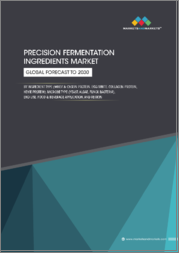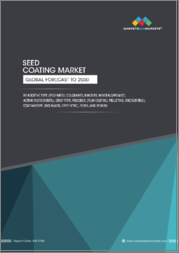
|
시장보고서
상품코드
1371522
세계의 정밀 발효 성분 시장 : 성분 유형, 미생물, 용도, 최종사용자, 사업 규모, 유통 채널, 지역별 기회 및 예측(2016-2030년)Precision Fermentation Ingredients Market Assessment, By Ingredient Type, By Microbes, By Application, By End-user, By Size of Business, By Distribution Channel, By Region, Opportunities and Forecast, 2016-2030F |
||||||
세계의 정밀 발효 성분 시장 규모는 2022년 31억 달러에서 예측 기간 중 35.3%의 CAGR로 추이하며, 2030년에는 348억 달러 규모로 성장할 것으로 예측됩니다. 이 시장은 단백질이 풍부한 식품의 친환경적 생산을 위한 지속가능한 대체 단백질 공급원에 대한 수요 증가로 인해 역동적이고 빠르게 성장하고 있습니다. 이러한 변화는 식물 및 세포 유래 제품에 대한 소비자의 선호도가 높아지면서 기존의 동물성 성분을 대체할 수 있는 미생물 유래 제품에 대한 수요가 증가하고 있는 것과 일치합니다. 생명공학 및 합성생물학의 발전으로 미생물을 가공하여 향료, 향료, 효소, 비타민 등의 성분을 맞춤형으로 생산할 수 있는 정밀 발효 기술이 개발되고 있으며, 이 기술의 자원 효율성, 맞춤화 능력, 비용 효율성으로 인해 다양한 산업에서 채택되고 있습니다. 하고 있습니다.
화장품 및 퍼스널케어 분야 발효 성분 수요 증가
세계 정밀 발효 성분 시장은 화장품 및 퍼스널케어 분야에서 발효 성분에 대한 수요가 급증하고 있습니다. 정밀 발효 기술은 스킨케어, 헤어케어 및 기타 퍼스널케어 제품에 사용되는 생리활성 화합물, 효소 및 특수 성분을 생산할 수 있는 길을 열어주었습니다. 이 공정은 효능과 생체 이용률을 높이는 유익한 성분의 제어된 생산을 가능하게 합니다. 소비자들이 점점 더 자연스럽고 지속가능한 대안을 찾고 있는 가운데, 정밀 발효는 클린 뷰티 운동에 부합하는 혁신적이고, 친환경적이며, 친환경적인 성분을 제공함으로써 이러한 기대에 부응하고 있습니다.
비건 & 미트프리 라이프스타일의 확대
비건 및 육류 섭취를 하지 않는 라이프스타일의 확산도 이 시장의 중요한 촉진요인입니다. 더 많은 소비자들이 식물성 식습관을 받아들이고 기존 동물성 제품의 대안을 찾으면서 정밀 발효 성분에 대한 수요가 급증하고 있습니다.
세계의 정밀 발효 성분 시장을 조사했으며, 시장의 정의와 개요, 시장 규모의 추이·예측, 각종 구분·지역별 상세 분석, 산업 구조, 시장 성장에 대한 영향요인 분석, 사례 연구, 경쟁 구도, 주요 기업의 개요 등을 정리하여 전해드립니다.
목차
제1장 조사 방법
제2장 프로젝트의 범위와 정의
제3장 세계의 정밀 발효 성분 시장에 대한 COVID-19의 영향
제4장 러시아·우크라이나 전쟁의 영향
제5장 주요 요약
제6장 고객의 소리
- 품질과 성능
- 건강과 영양
- 지속가능성과 환경에 대한 영향
- 클린 라벨과 투명성
- 비용과 가치
- 규제기관 승인과 안전성
- 혁신성과 독자성
- 소비자 인식과 의식
- 용도와의 궁합
- 통합 용이성
- 공급망과 가용성
- 브랜드 평판과 신뢰
- 시장 동향과 영향
제7장 세계의 정밀 발효 성분 시장 전망
- 시장 규모·예측
- 성분 유형별
- 단백질
- 효소
- 향료 & 향수 화합물
- 미생물별
- 효모
- 조류
- 세균
- 기타
- 용도별
- 고기·어개류
- 유제품 대체품
- 계란 대체품
- 기타
- 최종사용자별
- 식품
- 헬스케어·의약품
- 퍼스널케어·화장품
- 사업 규모별
- 중소기업
- 대기업
- 유통 채널별
- 제조업체에 직송
- 소매·소비자
- 지역별
- 북미
- 아시아태평양
- 유럽
- 남미
- 중동 및 아프리카
- 기업 점유율
제8장 정밀 발효 성분 시장의 전망 : 지역별
- 북미
- 유럽
- 남미
- 아시아태평양
- 중동 아프리카
- 시장 규모·예측
- 성분 유형별
- 미생물별
- 용도별
- 최종사용자별
- 사업 규모별
- 유통 채널별
- 국가별
제9장 시장 매핑
제10장 거시환경과 산업 구조
- 수급 분석
- 수출입 분석
- 밸류체인 분석
- PESTEL 분석
- Porter's Five Forces 분석
제11장 시장 역학
- 성장 촉진요인
- 성장 억제요인(과제·제약)
제12장 주요 기업의 상황
- 시장 리더 상위 5사의 경쟁 매트릭스
- 시장 리더 상위 5사의 시장 매출 분석
- M&A·조인트 벤처(해당하는 경우)
- SWOT 분석(참여 5사)
- 특허 분석(해당하는 경우)
제13장 가격 분석
제14장 사례 연구
제15장 주요 기업의 전망
- Lonza Group AG.
- Ajinomoto Co Inc.
- BASF SE
- Cargill Inc
- Associated British Foods plc
- GELTOR
- Change Foods
- Remilk Ltd.
- Melt&Marble.
- Impossible Foods Inc
- Mycorena, Myco Technology
- Triton Algae Innovations
제16장 전략적 권장사항
제17장 Market Xcel - Markets and Data 소개·면책사항
KSA 23.11.13Global precision fermentation ingredients market size was valued at USD 3.1 billion in 2022, expected to reach USD 34.8 billion in 2030, with a CAGR of 35.3% for the forecast period between 2023 and 2030. The global precision fermentation ingredients market is dynamic and rapidly expanding due to factors such as the increasing demand for sustainable and alternative protein sources to produce protein-rich ingredients with reduced environmental impact. The shift aligns with the growing consumer preference for plant and cell-based products, prompting the exploration of microbial-derived ones to replace traditional animal-derived components. Biotechnology and synthetic biology advancements have paved the way for precision fermentation to engineer microorganisms for tailored ingredient production, including flavors, fragrances, enzymes, and vitamins. The technology's resource efficiency, customization capabilities, and cost-effectiveness further fuel its adoption across diverse industries.
Regulatory support and safety approvals provide the necessary framework for market growth. Continuous investment in precision fermentation companies fosters innovation and develops novel ingredients and applications. As health and nutrition trends gain momentum, precision fermentation responds with bioactive components and functional ingredients, meeting consumer demands for holistic well-being. The global precision fermentation ingredients market is addressing current market needs and ushering to a new era of sustainable, customizable, and innovative ingredient production. For example, in early 2023, a consortium of nine worldwide leaders in precision fermentation has collaboratively launched the precision fermentation alliance. The novel coalition aims to advocate and endorse precision fermentation as a reliable strategy for cultivating a food system that is both resilient and sustainable.
For example, on March 7, 2023, Triton Algae Innovations, a forward-thinking food startup based in San Diego, unveiled an innovative consumer packaged goods (CPG) offering. The new product is an Asian-style dumpling filled with cabbage, onion, and a pork alternative. Branded as "Too Good To Be" (TGTB), this dumpling marks Triton Algae Innovations' entry into the market. The official launch was scheduled for the annual Natural Products Expo West Trade Show.
Advancements in Biotechnology and Synthetic Biology
Biotechnology and synthetic biology advancements have propelled the global precision fermentation ingredients market to newer heights in food production. Integrating the innovative disciplines has enabled precise engineering of microorganisms, fostering the creation of specialized ingredients with unparalleled control and efficiency. Precision fermentation can yield diverse food components, from proteins and enzymes to flavors and nutritional additives, by designing microbial hosts to express desired traits and perform specific functions. This level of customization aligns with evolving consumer demands for sustainable, healthy, and ethically sourced products. As biotechnology and synthetic biology continue to evolve, they fuel innovation in the precision fermentation field, driving the development of novel food ingredients that cater to the dynamic landscape of modern dietary preferences.
For instance, in 2023, many firms have emerged in recent times, focusing on creating milk proteins via yeast or fungi. Perfect Day, a dairy company based in California, is a participant in the unique landscape. These companies have successfully brought their products, frequently labelled as "animal-free" to retail shelves, manifesting as yogurt, cheese, and ice cream. This flourishing sector, referred to as "precision fermentation," boasts its own industry association, with major players in food industry such as Nestle, Starbucks, and General Mills joining the ranks as clients.
Increasing Demand for Fermented Ingredients in Cosmetics and Personal Care
The global precision fermentation ingredients market is experiencing a surge in demand for fermented ingredients in the cosmetics and personal care sectors. Precision fermentation technology has opened avenues for producing bioactive compounds, enzymes, and specialty ingredients used in skincare, haircare, and other personal care products. The process allows for the controlled production of beneficial components that offer enhanced efficacy and bioavailability. As consumers increasingly seek natural and sustainable alternatives, precision fermentation meets these expectations by providing innovative, cruelty-free, and eco-friendly ingredients that align with the clean beauty movement.
The trend underscores the technology's versatile application in creating high-performance, bioactive formulations that cater to evolving preferences for safe and efficacious cosmetic solutions. For example, Geltor has unveiled Caviance, a remarkable achievement that seamlessly blends luxury, sustainability, and innovative scientific innovation. The novel polypeptide capitalizes on the distinctive attributes of type II sturgeon collagen, offering a range of advantages for both skin rejuvenation and calming effects. Notably, Caviance is a product of precision fermentation, boasting certifications for being vegan, cruelty-free, Halal, and non-GMO.
Growing Adoption of Vegan and Meat-Free Lifestyles
The growing adoption of vegan and meat-free lifestyles has emerged as a significant driver for the global precision fermentation ingredients market. As more consumers embrace plant-based diets and seek alternatives to traditional animal-derived products, the demand for precision fermentation-derived ingredients has surged. This shift aligns with the market's capacity to produce sustainable and protein-rich components that mimic animal-based products' texture, taste, and nutritional profiles.
Precision fermentation's versatility in creating a range of ingredients, such as proteins, flavors, and functional additives, positions it as a pivotal player in catering to the evolving preferences of health-conscious and environmentally aware consumers, thereby fostering innovation and growth in the market. For example, Impossible indulgent burger patties made from plants has a taste and luxury alike top-quality beef. Perfect for special moments where excellence, flavor, and indulgence matter. Surprisingly, 82% of their consumers found that the products matched or exceeded the taste of traditional ground beef.
Impact of COVID-19
The pandemic had a multifaceted impact on the global precision fermentation ingredients market. While disruptions in supply chains and temporary closures of production facilities initially hampered operations, the crisis underscored the need for resilient and sustainable ingredient sourcing. As consumer preferences shifted towards health and wellness, the market witnessed increased demand for precision fermentation-derived functional and nutritional ingredients. Additionally, the pandemic highlighted the importance of reducing reliance on traditional agriculture and animal-based production, driving interest in alternative protein sources, and accelerating the adoption of precision fermentation technologies. Despite short-term challenges, the pandemic ultimately reinforced the market's trajectory towards innovation, sustainability, and the integration of advanced biotechnologies.
Impact of Russia-Ukraine War
The Russia-Ukraine war had significant geopolitical uncertainties that potentially has impacted the global precision fermentation ingredients market. Disruptions in trade routes, supply chain interruptions, and geopolitical tensions led to challenges in sourcing key raw materials and exporting finished products. Fluctuating the region's currency values and economic instability affecting market dynamics and consumer purchasing power. The conflict's broader implications for global trade and political stability influenced investor confidence and business decisions, potentially slowing down investments and innovation in the precision fermentation sector. To mitigate these potential effects, industry stakeholders needed to diversify supply chains, explore new markets, and closely monitor geopolitical developments to ensure the continued growth and stability of the market.
Key Player Landscape and Outlook
A mix of established companies and emerging innovators characterize the landscape of key players in the global precision fermentation ingredients market. Established industry leaders have successfully scaled precision fermentation processes and contributed significantly to the market growth. These players often possess a diverse portfolio of precision fermentation-derived ingredients, catering to food, cosmetics, healthcare, etc. Meanwhile, startups and smaller enterprises are introducing fresh perspectives, driving innovation through novel applications and ingredients. The market is optimistic, fueled by the increasing demand for sustainable and customized ingredients. Collaboration between established giants and agile startups is expected to foster a dynamic ecosystem that propels the advancement of precision fermentation technologies and their integration into mainstream product development.
For instance, in 2023, Cauldron successfully garnered USD 6.98 million from local and global investors. The funding aims to facilitate the enlargement of their current pilot plant, establishing a nationwide production network, and form a team comprising leading precision fermentation experts on a global scale.
For instance, in 2023, Novozymes and Arla Foods Ingredients have united their efforts to leverage the capabilities of precision fermentation. These two prominent figures in biotechnology and nutrition have forged a collaborative partnership to advance the development of sophisticated protein ingredients.
Table of Contents
1. Research Methodology
2. Project Scope & Definitions
3. Impact of COVID-19 on Global Precision Fermentation Ingredients Market
4. Impact of Russia-Ukraine War
5. Executive Summary
6. Voice of Customer
- 6.1. Quality and Performance
- 6.2. Health and Nutrition
- 6.3. Sustainability and Environmental Impact
- 6.4. Clean Label and Transparency
- 6.5. Cost and Value
- 6.6. Regulatory Approval and Safety
- 6.7. Innovation and Uniqueness
- 6.8. Consumer Perception and Awareness
- 6.9. Compatibility with Applications
- 6.10. Ease of Integration
- 6.11. Supply Chain and Availability
- 6.12. Brand Reputation and Trust
- 6.13. Market Trends and Influences
7. Global Precision Fermentation Ingredients Market Outlook, 2016-2030F
- 7.1. Market Size & Forecast
- 7.1.1. By Value
- 7.1.2. By Volume
- 7.2. By Ingredient Type
- 7.2.1. Proteins
- 7.2.2. Enzymes
- 7.2.3. Flavor & Fragrance Compounds
- 7.3. By Microbes
- 7.3.1. Yeast
- 7.3.2. Algae
- 7.3.3. Bacteria
- 7.3.4. Others
- 7.4. By Application
- 7.4.1. Meat & Seafood
- 7.4.2. Dairy Alternatives
- 7.4.3. Egg Alternatives
- 7.4.4. Others
- 7.5. By End-user
- 7.5.1. Food Industry
- 7.5.2. Healthcare & Pharmaceuticals
- 7.5.3. Personal Care & Cosmetics Industry
- 7.6. By Size of Business
- 7.6.1. Small & Medium Enterprises (SMEs)
- 7.6.2. Large Enterprises
- 7.7. Distribution Channel
- 7.7.1. Direct to Manufacturers
- 7.7.2. Retail & Consumer Channels
- 7.8. By Region
- 7.8.1. North America
- 7.8.2. Europe
- 7.8.3. South America
- 7.8.4. Asia-Pacific
- 7.8.5. Middle East and Africa
- 7.9. By Company Market Share (%), 2022
8. Global Precision Fermentation Ingredients Market Outlook, By Region, 2016-2030F
- 8.1. North America*
- 8.1.1. Market Size & Forecast
- 8.1.1.1. By Value
- 8.1.1.2. By Volume
- 8.1.2. By Ingredient Type
- 8.1.2.1. Proteins
- 8.1.2.2. Enzymes
- 8.1.2.3. Flavor & Fragrance Compounds
- 8.1.3. By Microbes
- 8.1.3.1. Yeast
- 8.1.3.2. Algae
- 8.1.3.3. Bacteria
- 8.1.3.4. Others
- 8.1.4. By Application
- 8.1.4.1. Meat & Seafood
- 8.1.4.2. Dairy Alternatives
- 8.1.4.3. Egg Alternatives
- 8.1.4.4. Others
- 8.1.5. By End-user
- 8.1.5.1. Food Industry
- 8.1.5.2. Healthcare & Pharmaceuticals
- 8.1.5.3. Personal Care & Cosmetics Industry
- 8.1.6. By Size of Business
- 8.1.6.1. Small & Medium Enterprises (SMEs)
- 8.1.6.2. Large Enterprises
- 8.1.7. Distribution Channel
- 8.1.7.1. Direct to Manufacturers
- 8.1.7.2. Retail & Consumer Channels
- 8.1.8. United States*
- 8.1.8.1. Market Size & Forecast
- 8.1.8.1.1. By Value
- 8.1.8.1.2. By Volume
- 8.1.8.2. By Ingredient Type
- 8.1.8.2.1. Proteins
- 8.1.8.2.2. Enzymes
- 8.1.8.2.3. Flavor & Fragrance Compounds
- 8.1.8.3. By Microbes
- 8.1.8.3.1. Yeast
- 8.1.8.3.2. Algae
- 8.1.8.3.3. Bacteria
- 8.1.8.3.4. Others
- 8.1.8.4. By Application
- 8.1.8.4.1. Meat & Seafood
- 8.1.8.4.2. Dairy Alternatives
- 8.1.8.4.3. Egg Alternatives
- 8.1.8.4.4. Others
- 8.1.8.5. By End-user
- 8.1.8.5.1. Food Industry
- 8.1.8.5.2. Healthcare & Pharmaceuticals
- 8.1.8.5.3. Personal Care & Cosmetics Industry
- 8.1.8.6. By Size of Business
- 8.1.8.6.1. Small & Medium Enterprises (SMEs)
- 8.1.8.6.2. Large Enterprises
- 8.1.8.7. Distribution Channel
- 8.1.8.7.1. Direct to Manufacturers
- 8.1.8.7.2. Retail & Consumer Channels
- 8.1.9. Canada
- 8.1.10. Mexico
- 8.1.1. Market Size & Forecast
All segments will be provided for all regions and countries covered:
- 8.2. Europe
- 8.2.1. Germany
- 8.2.2. France
- 8.2.3. Italy
- 8.2.4. United Kingdom
- 8.2.5. Russia
- 8.2.6. Netherlands
- 8.2.7. Spain
- 8.2.8. Turkey
- 8.2.9. Poland
- 8.3. South America
- 8.3.1. Brazil
- 8.3.2. Argentina
- 8.4. Asia-Pacific
- 8.4.1. India
- 8.4.2. China
- 8.4.3. Japan
- 8.4.4. Australia
- 8.4.5. Vietnam
- 8.4.6. South Korea
- 8.4.7. Indonesia
- 8.4.8. Philippines
- 8.5. Middle East & Africa
- 8.5.1. Saudi Arabia
- 8.5.2. UAE
- 8.5.3. South Africa
9. Market Mapping, 2022
- 9.1. By Ingredient Type
- 9.2. By Microbes
- 9.3. By Application
- 9.4. By End-user
- 9.5. By Size of Business
- 9.6. Distribution Channel
10. Macro Environment and Industry Structure
- 10.1. Supply Demand Analysis
- 10.2. Import Export Analysis
- 10.3. Value Chain Analysis
- 10.4. PESTEL Analysis
- 10.4.1. Political Factors
- 10.4.2. Economic System
- 10.4.3. Social Implications
- 10.4.4. Technological Advancements
- 10.4.5. Environmental Impacts
- 10.4.6. Legal Compliances and Regulatory Policies (Statutory Bodies Included)
- 10.5. Porter's Five Forces Analysis
- 10.5.1. Supplier Power
- 10.5.2. Buyer Power
- 10.5.3. Substitution Threat
- 10.5.4. Threat from New Entrant
- 10.5.5. Competitive Rivalry
11. Market Dynamics
- 11.1. Growth Drivers
- 11.2. Growth Inhibitors (Challenges and Restraints)
12. Key Players Landscape
- 12.1. Competition Matrix of Top Five Market Leaders
- 12.2. Market Revenue Analysis of Top Five Market Leaders (in %, 2022)
- 12.3. Mergers and Acquisitions/Joint Ventures (If Applicable)
- 12.4. SWOT Analysis (For Five Market Players)
- 12.5. Patent Analysis (If Applicable)
13. Pricing Analysis
14. Case Studies
15. Key Players Outlook
- 15.1. Lonza Group AG.
- 15.1.1. Company Details
- 15.1.2. Key Management Personnel
- 15.1.3. Products & Services
- 15.1.4. Financials (As reported)
- 15.1.5. Key Market Focus & Geographical Presence
- 15.1.6. Recent Developments
- 15.2. Ajinomoto Co Inc.
- 15.3. BASF SE
- 15.4. Cargill Inc
- 15.5. Associated British Foods plc
- 15.6. GELTOR
- 15.7. Change Foods
- 15.8. Remilk Ltd.
- 15.9. Melt&Marble.
- 15.10. Impossible Foods Inc
- 15.11. Mycorena, Myco Technology
- 15.12. Triton Algae Innovations
Companies mentioned above DO NOT hold any order as per market share and can be changed as per information available during research work.



















